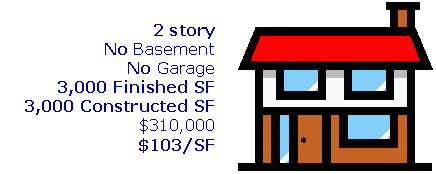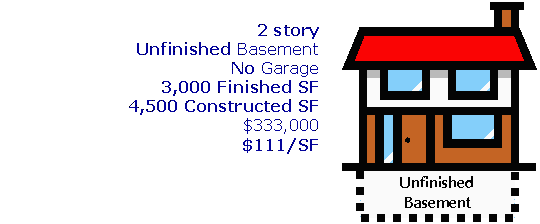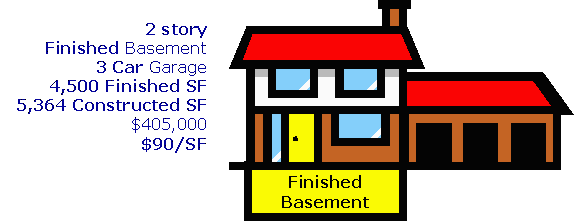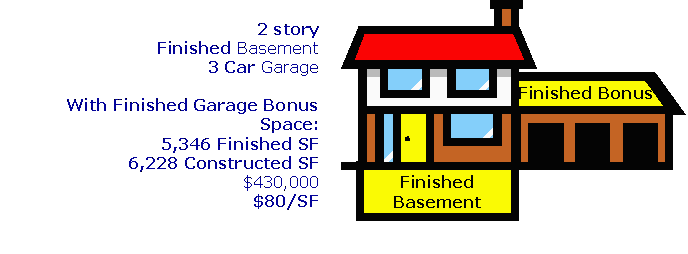This section will briefly discuss the Square Foot Trap: "Finished SF vs. Constructed SF" and the reasons why cost per SF budgets are ultimately unreliable as predictors of construction cost for a specific home design. Although we offer a free cost per SF tool for any state, there are still risks with assuming a cost per SF budget will represent your specific costs.
Finished SF is the number you hear all the time when someone says their house is 2,500 SF or 3,800 SF, and includes all livable or heated area from outside wall to outside wall.
But there is a second number you rarely hear about called Constructed SF which has a major impact on construction cost. Constructed SF is one of most significant factors skewing $/SF rules of thumb. Just because unfinished garages and basements are not livable does not mean they are free to construct. Unfinished areas and bonus spaces drive costs up with no livable SF benefit.
Impact of Quality Levels:
It is worth noting that in addition to the issues of Constructed and Finished SF which we will discuss in a moment, there is another significant variable that makes the cost per SF metric unreliable. That variable is Quality, the quality level of the home's construction materials and finishes.  You see in Example 1 [below], the $/SF cost is $103/SF based on a $310,000 construction cost. Now that's assuming basic interior finishes, but what happens if we went with custom cherry kitchen cabinets, granite counters, hardwood baseboard, door and window trim, wool carpet, whirlpool tubs, custom showers, etc. Well, you get the idea.
You see in Example 1 [below], the $/SF cost is $103/SF based on a $310,000 construction cost. Now that's assuming basic interior finishes, but what happens if we went with custom cherry kitchen cabinets, granite counters, hardwood baseboard, door and window trim, wool carpet, whirlpool tubs, custom showers, etc. Well, you get the idea.
The home cost would go up, right? Let's assume it goes up to $370,000. The home cost $/SF is now up from $103/SF to a new number of $123/SF. Did the Finished SF or Constructed SF increase? No. But the $/SF sure did. Remember, quality level of the materials has significant impact of cost. And one person's definition of Standard or Luxury is different than another's, so categories like that do little to clarify quality level assumptions.
Resi-Cost solves this problem because its patented estimating technology considers all quality and scope variables at one time, along with impacts of regional labor and material costs and sales tax. But let's put quality levels aside for a moment and get back to Finished vs. Constructed SF since that has a more significant impact on Cost per SF.
The Impacts of Finished vs. Constructed SF:
As you will see in the 5 examples below, the conversion of Finished and Constructed spaces skew and make the $/SF metric useless as a predictor of costs.
EXAMPLE 1
OK, let's start with a simple 2 story home on a slab; no garage and no basement. Note here that the amount of Finished SF is 3,000 SF. This is the number generally used when talking about the size of a home. Please also note that the Constructed SF is 3,000 SF. 
EXAMPLE 2
Now here we see the same house but with the addition of an unfinished walkout basement. You see the Constructed SF went up by 1,500 SF resulting in an increase to cost. But because the Finished SF stayed the same (since the walkout basement is unfinished), the $/SF went up from $103/SF to $111/SF. 
EXAMPLE 3
Now in addition to the unfinished walkout basement we construct a 3 car garage. That increase the Constructed SF from 4,500 SF to 5,364 SF. Have we increased our Finished SF? No. That remains at 3,000 SF. Cost now is up from the original $103/SF to a new $127/SF.
Now say we built the garage so that it had a floor above for "bonus space". It's cheap right? Constructed SF now increases again to 6,228 SF from the original 3,000 SF and as before, the Finished SF remains at 3,000 SF. Cost is now up $78,000 to $388,000 from the original $310,000 (with no additional living SF); and cost per SF is now standing at $129/SF.
EXAMPLE 4
So now the would-be-homebuilder thinks "Since I'm building the walkout basement anyway, why not finish it out? It's cheap" This decision increase the Finished SF from 3,000 SF to 4,500 SF and INCREASES construction cost from the original $310,000 to a new $405,000. However it DECREASES $/SF from $127/SF to $90/SF.
EXAMPLE 5
In our last example we see the utter failure of $/SF estimating. Let's say our would-be homebuilder now decides to finish out the bonus space over the garage since finishing out the basement was such a deal. Our original Finished SF has now increased from 3,000 SF to a new 5,346 SF, and Constructed SF went from the original 3,000 SF to a new figure of 6,228 SF.
Overall cost? Well that INCREASED the original $310,000 to $430,000 but REDUCED the $/SF cost from the original $103/SF to $80/SF.
SUMMARY
As can be seen by the above examples, the cost for this house ranged from $129/SF to $80/SF. That's the reason you always get evasive ranges and "It Depends" answers from architects and builders. And that's also why using $/SF for accurate home cost estimating will always be a myth and will place you squarely in the cost trap, every time.
It is this exact problem that Resi-Cost solves and helps you avoid. Unless of course you don't mind a range of $49/SF in your estimate. (Yes, we thought you would.)